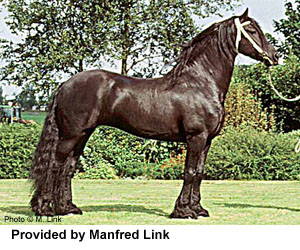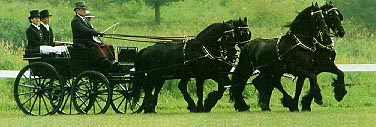

Friesian


Introduction: In 1662, English horses were described as ". . . (neither) so slovenly as the Flemish . . . nor so earthy as those in the low countries . . ."--an unflattering allusion that might fit the so-called "Flanders mare" type, but which could be scarcely less true of the proud, picturesque Friesian. A breed of national importance in Holland (the Netherlands), the Friesian was in danger of becoming extinct in the early twentieth century. If you have any comments or suggestions, please click here.
Names: Friesian. Sometimes spelled Frisian; I will use the more common spelling. It got its name from the part of the Netherlands where it originated: Friesland. Known at one time as the Harddraver, meaning "good trotter" in Dutch.
Origin: From
Friesland, in the Netherlands. This is one of the oldest breeds in Europe
and was much in demand in the Middle Ages as a war horse. The original Friesians were used in
war-chariots of early Christian times. Crossed with Andalusians,
they then became one of the most popular horses of the Middle Ages and appear
frequently as knights' coursers in the paintings of the old Dutch masters.
Although greatly influenced by the addition of Andalusian
and Oriental blood, the modern
breed still retains the characteristics of its ancestors.
According to one source, the exact origins of the Friesian
are unknown, but a similar type of heavy horse existed more than 3,000 years ago
in the northern Netherlands.
Breeding: Shortly before World War I, only three Friesian stallions remained, but some imaginative Friesian farmers managed to preserve their excellent horses by rebuilding the breed with careful use of Oldenburgs and the remaining stock. Trotting was popular in Holland long before it became a world-wide sport and exported Friesian (Harddraver) horses helped to found the American and other Trotters.
Description: A horse of the meso-brachymorphic type with a compact build and superb bearing.
Action: High. It has an active trot.
Body: Strong and compact, with broad, deep chest; long, sloping shoulder; straight, short back; broad loins; rounded flanks; and muscular, sloping croup. Withers broad, but not very prominent; neck quite short, but well-arched.
Color: Always black, very rarely presenting white markings on the head only.
Hair: Thick, curly, and profuse mane and tail. Full forelock. Some feather below the cannons.
Head: Fine, long and narrow, with straight profile, short, pointed ears, and gentle, expressive eyes.
Hooves: Large and strong.
Legs: Short and muscular, with broad joints.
Size: About 15 hands (1.52 meters).
Temperament: Good tempered but sensitive nature that does ". . . not suffer fools gladly." Docile and responsive. Quiet, willing, hard-working, and active.
Features: Strong and kindly. Hard-working. Excellent trotting horse.
Uses: Draft, farm work, and riding. Works mostly in harness. Once a war horse, they have found favor in more recent times as harness and farm horses. An excellent trotter, the Friesian was frequently used as a carriage horse; it has, together with the Hackney, which itself derives from the Friesian, contributed to the formation of all competitive trotting breeds.
Accomplishments:
Curiosities: In 1644, a Princess of Oldenburg gave the Duke of Newcastle a "Friesland" horse.
Profiles:
Conclusion: